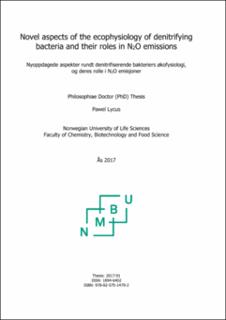| dc.contributor.advisor | Frostegård, Åsa | |
| dc.contributor.advisor | Bakken, Lars | |
| dc.contributor.advisor | Bergaust, Linda | |
| dc.contributor.author | Lycus, Pawel Michal | |
| dc.date.accessioned | 2020-11-25T10:26:42Z | |
| dc.date.available | 2020-11-25T10:26:42Z | |
| dc.date.issued | 2017 | |
| dc.identifier.isbn | 978-82-575-1479-2 | |
| dc.identifier.issn | 1894-6402 | |
| dc.identifier.uri | https://hdl.handle.net/11250/2689526 | |
| dc.description.abstract | Environmental bacteria are in general limited by nutrient availability, and as
the conditions fluctuate rapidly and unpredictably they must adapt or they
will not thrive. This requires fast and adequate sensing and responding
mechanisms, assuring fitness with minimum investment, as there is not much
energy to be wasted. The common notion about the regulatory biology of
denitrification is based on detailed studies of only a few model organisms.
Although the gene regulatory networks of these organisms share some
common traits, there is a substantial variation in the way organisms tackle
transition from aerobic respiration to denitrification, and in the levels they
accumulate intermediates. This knowledge, however, only arose from
studies of model organisms and there is a need to validate its importance in
the natural settings. Denitrification as a sequential reduction of nongaseous
nitrate (NO3
-) and nitrite (NO2
-) to gaseous nitric oxide (NO), nitrous oxide
(N2O) and dinitrogen gas (N2), is a key process in the nitrogen cycle, yet its
two gaseous intermediate products have great impact on the climate (N2O)
and the chemistry of the troposphere (NO). In addition to its global forcing,
N2O is also destroys stratospheric ozone, and the emission of this gas has
attracted the attention of researchers and ecologists. Agricultural soils are
the main source of anthropogenic N2O emission and in order to develop
mitigation strategies, there is a need for understanding the mechanism of
N2O production and reduction. There is ample evidence, that the
N2O/(N2O+N2) product ratio of the denitrification process depends on several
factors, among which the ambient pH is a dominant driver. Other processes
within the nitrogen cycle can also liberate N2O, however, denitrification is the largest source of it, and up to date, there is only one biological sink for this
N2O – a multicopper-dependent nitrous oxide reductase (N2OR, NosZ). The
enzyme that carries the two-electron reduction of N2O to N2 is located in the
bacterial periplasm, where its maturation and assembly takes place.
Combining facts of pH dependent N2O reduction in natural settings and the
subcellular localization of N2OR I started to investigate the processes laying
behind.
In Paper I, we have tested the relevance of the observation obtained from
model denitrifying bacteria and we do see that phenomena ascribed to them
are also occurring in the nature. Moreover, we see that the presence of the
nosZ gene does not correspond with the function in over 20% of investigated
organisms.
The second paper reveals the undescribed bet-hedging survival strategy in
the denitrifying bacterium Paracoccus denitrificans, which improves its
fitness, minimizes costs of protein expression and has great ecological
influence, as the majority of the isogenic bacterial population acts as a strong
sink for the N2O greenhouse gas.
In Paper III we try to explain why acidic soils are the major source of the N2O.
To our understanding the ambient pH hampers the maturation of copper in
the N2OR enzyme, thus causes the emissions. The preliminary results, that
we have obtained so far, support our hypothesis. | en_US |
| dc.description.abstract | Bakterier i naturlig miljø er normalt begrenset av tilgang på substrat, og de utfordres av hyppige endringer i miljøbetingelsene. For å overleve disse endringene må de for det første ha sensorer som merker endringen, og som initierer tilpasningen. Tilpasning er normalt synonymt med produksjon av nye enzymer. Dette koster energi, som er en minimumsfaktor. Overleving (fitness) er derfor ikke bare avhengig av adekvat respons, men også at energiforbruket til dette minimeres. Denitrifiserende bakterier svarer på oksygenmangel ved å uttrykke gener som koder for et sett med enzymer som setter dem i stand til å respirere ved å redusere nitrogen-oksyder. Det regulatoriske nettverket for disse genene er undersøkt i et fåtall modellorganismer, og disse viser noen felles trekk, men betydelig variasjon, som har konsekvenser for deres produksjon av intermediater. Det er et åpenbart behov for å studere denne regulatoriske biologien i flere, og ikke minst mer økologisk relevante organismer. | en_US |
| dc.description.sponsorship | Nitrous Oxide Research Alliance (NORA), a Marie Skłodowska-Curie ITN research project under the EU͛s seventh framework
programme | en_US |
| dc.language.iso | eng | en_US |
| dc.publisher | Norwegian University of Life Sciences, Ås | en_US |
| dc.relation.ispartofseries | PhD Thesis;2017:91 | |
| dc.rights | Attribution-NonCommercial-NoDerivatives 4.0 Internasjonal | * |
| dc.rights.uri | http://creativecommons.org/licenses/by-nc-nd/4.0/deed.no | * |
| dc.subject | ecophysiology of bacteria | en_US |
| dc.subject | denitrification | en_US |
| dc.subject | bet-hedging | en_US |
| dc.subject | isolation of bacteria | en_US |
| dc.subject | nitrous oxide | en_US |
| dc.title | Novel aspects of the ecophysiology of denitrifying bacteria and their roles in N2O emissions | en_US |
| dc.title.alternative | Nyoppdagede aspekter rundt denitrifiserende bakteriers økofysiologi, og deres rolle i N2O emisjoner | en_US |
| dc.type | Doctoral thesis | en_US |
| dc.relation.project | EC/FP7/316472 | en_US |

